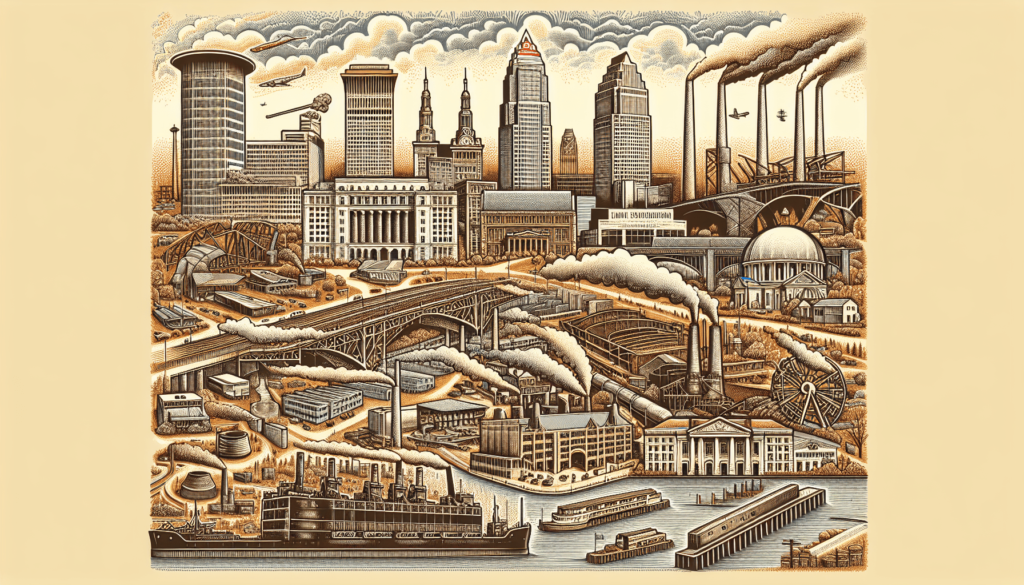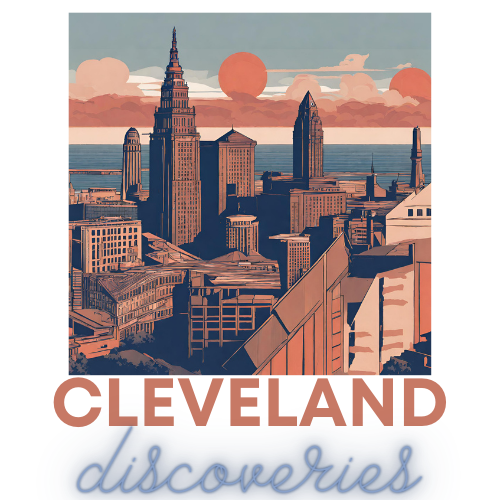Cleveland, the vibrant city perched on the southern shores of Lake Erie, will take you on a remarkable journey through its rich industrial past. With a legacy deeply rooted in steel, manufacturing, and innovation, there are a plethora of attractions awaiting your exploration. The Cleveland History Center, housed in the impressive Western Reserve Historical Society, offers a captivating glimpse into the city’s industrial heritage through its extensive collection of artifacts and exhibits. The Industrial Heritage Trail weaves through scenic neighborhoods, revealing the historic landmarks and iconic structures that once shaped Cleveland’s industrial landscape. Whether you choose to explore the sprawling steel mills or dive into the captivating stories of the people who fueled Cleveland’s industrial prowess, this city is a treasure trove of fascinating attractions ready to dazzle you with its industrial charm.
Steamship William G. Mather Museum
Introduction to the museum
The Steamship William G. Mather Museum is a fascinating attraction that offers visitors a unique opportunity to step back in time and experience Cleveland’s rich industrial history firsthand. The museum is located on the historic Great Lakes freighter, the William G. Mather, which was once a vital part of the shipping industry that played a key role in Cleveland’s economic growth. Today, the ship has been lovingly restored and transformed into a museum that provides a captivating glimpse into the past.
Exploring the ship’s history
As you explore the Steamship William G. Mather Museum, you’ll have the chance to learn all about the ship’s storied history and its pivotal role in shaping Cleveland’s industrial landscape. From its maiden voyage in 1925 to its retirement in 1980, the William G. Mather was instrumental in transporting goods and materials throughout the Great Lakes region. The exhibits and displays on board the ship offer a comprehensive overview of the vessel’s history, allowing you to gain a deeper understanding of its significance.
Interacting with exhibits and displays
One of the highlights of visiting the Steamship William G. Mather Museum is the chance to interact with the exhibits and displays on board. You can step into the captain’s quarters and imagine what life was like for the ship’s crew, or explore the engine room and marvel at the engineering marvels of the past. Whether you’re interested in the intricate machinery or the daily life of the sailors, there’s something for everyone to enjoy and learn from. The museum also offers guided tours and educational programs, making it a great destination for visitors of all ages.
Cleveland History Center
Overview of the Cleveland History Center
The Cleveland History Center is a comprehensive museum that provides a captivating look at Cleveland’s past, with a particular focus on its industrial heritage. Situated in University Circle, the center offers an array of exhibits and displays that showcase the city’s transformation from a small trading post to a bustling industrial powerhouse. With its extensive collection of artifacts and interactive exhibits, the Cleveland History Center is a must-visit attraction for anyone interested in learning about the city’s industrial past.
Exhibits on Cleveland’s industrial past
At the Cleveland History Center, you’ll find a variety of exhibits that delve into Cleveland’s industrial history. From the city’s early days as a center for manufacturing and trade to its rise as a major steel producer, these exhibits chronicle the milestones and challenges that shaped Cleveland’s industrial landscape. You can explore recreations of factories, learn about the influential industrialists who shaped the city’s growth, and discover the innovative technologies that drove its success. The exhibits are thoughtfully curated and provide a comprehensive overview of Cleveland’s industrial past.
Highlights of the industry-focused exhibits
Among the many exhibits at the Cleveland History Center, there are several that stand out as must-see attractions for those interested in the city’s industrial heritage. The Crawford Auto-Aviation Museum offers a fascinating look at Cleveland’s role in the automotive and aviation industries, showcasing a collection of beautifully restored vintage cars and aircraft. The Bingham-Hanna Mansion exhibition takes you back to the Gilded Age and offers a glimpse into the opulent lifestyle of Cleveland’s wealthy industrialists. The Industry and Ingenuity exhibit highlights the city’s manufacturing prowess and showcases the technological innovations that helped Cleveland become an industrial powerhouse. These exhibits, among others, provide a comprehensive and engaging exploration of Cleveland’s industrial heritage.

This image is property of pixabay.com.
Cuyahoga Valley Scenic Railroad
Introduction to the Cuyahoga Valley Scenic Railroad
The Cuyahoga Valley Scenic Railroad is a delightful way to experience Cleveland’s industrial history while taking in the picturesque beauty of the surrounding landscape. The railroad, which stretches through the scenic Cuyahoga Valley National Park, offers visitors the chance to ride aboard historic trains and immerse themselves in the sights and sounds of a bygone era. Whether you’re a history enthusiast or simply looking for a unique way to explore the region, the Cuyahoga Valley Scenic Railroad is an experience you won’t want to miss.
Experience a historic train ride
When you embark on a journey with the Cuyahoga Valley Scenic Railroad, you’ll be transported back in time to an era when trains were the lifeblood of America’s industrial heartland. As you relax in the vintage coaches and listen to the rhythmic chugging of the locomotive, you’ll feel as though you’ve stepped into a different time. Along the route, you’ll pass through historic towns and witness the remnants of Cleveland’s industrial past, including old factories and warehouses. This immersive experience provides a unique perspective on the region’s industrial heritage.
Scenic views of industrial landmarks
While the Cuyahoga Valley Scenic Railroad offers a glimpse into Cleveland’s industrial history, it also provides stunning views of the region’s natural and man-made landmarks. As you travel through the Cuyahoga Valley National Park, you’ll be treated to breathtaking vistas of rolling hills, meandering rivers, and dense forests. In the distance, you may catch glimpses of iconic industrial landmarks, such as bridges, smokestacks, and the remnants of old factories. The juxtaposition of nature and industry creates a captivating tableau that truly captures the essence of Cleveland’s industrial past.
Cleveland Public Library – Main Branch
Overview of the Cleveland Public Library
The Cleveland Public Library, located in the heart of downtown Cleveland, is not only a treasure trove of books but also a repository of Cleveland’s industrial history. The Main Branch of the library houses the Burton Historical Collection, which contains a wealth of materials related to Cleveland’s industrial past. Whether you’re a history buff or a casual visitor, a trip to the Cleveland Public Library offers an opportunity to delve into the city’s industrial heritage through its vast archives.
Explore the Burton Historical Collection
The Burton Historical Collection is a veritable treasure trove for those interested in Cleveland’s industrial history. It houses a vast array of documents, photographs, and maps that chronicle the city’s growth as an industrial powerhouse. From blueprints of historic buildings to photographs of long-gone factories, the collection provides a fascinating glimpse into Cleveland’s industrial past. Whether you’re researching a specific topic or simply curious about the city’s history, the Burton Historical Collection is sure to satisfy your curiosity.
Discovering industrial history through archives
At the Cleveland Public Library, the archives of the Burton Historical Collection offer a unique opportunity to dive deeper into Cleveland’s industrial history. Researchers and history enthusiasts can access a wealth of primary sources, including newspapers, journals, and personal correspondence from the industrialists who shaped the city. Whether you’re interested in the growth of the steel industry or the impact of manufacturing on the city’s population, the archives provide a rich resource for exploring Cleveland’s industrial history.

The Cleveland Arcade
Introduction to the Cleveland Arcade
The Cleveland Arcade is a historic building located in downtown Cleveland that not only showcases the city’s architectural beauty but also pays homage to its industrial heritage. Built in 1890, the Arcade was one of the first indoor shopping malls in the United States and quickly became a symbol of Cleveland’s industrial prowess. Today, the Arcade is home to a variety of unique shops and businesses that celebrate the city’s industrial past.
History and significance of the building
The Cleveland Arcade holds a significant place in the city’s history, both architecturally and industrially. Designed by the architectural firm of John M. Eisenmann and George H. Smith, the Arcade features a stunning glass skylight and intricate ironwork, making it a testament to Cleveland’s commitment to both innovation and craftsmanship. The Arcade’s location on Euclid Avenue, once known as “Millionaire’s Row,” further solidifies its connection to Cleveland’s industrial elite. Over the years, the building has gone through various renovations, but its historical charm and industrial heritage remain intact.
Unique shops and businesses with an industrial theme
The Cleveland Arcade is not your typical shopping destination. Rather than housing chain stores and boutiques, the Arcade is home to a curated collection of unique businesses that celebrate Cleveland’s industrial heritage. From artisanal crafts to industrial-inspired fashion, the shops in the Arcade offer a wide range of products that pay homage to the city’s industrial past. Whether you’re looking for a one-of-a-kind gift or simply want to immerse yourself in the ambiance of yesteryear, a visit to the Cleveland Arcade is sure to delight.
Cleveland Industrial Exposition Building
Overview of the Industrial Exposition Building
The Cleveland Industrial Exposition Building, also known as the “Old Arcade,” is a historic structure nestled in downtown Cleveland that holds tremendous significance in the city’s industrial history. Built in 1888, the Exposition Building was originally intended to showcase the latest industrial advancements and innovations of the era. Today, the building stands as a testament to Cleveland’s industrial past and serves as a venue for a variety of events and exhibitions.
Historical context and significance
The Industrial Exposition Building played a crucial role in promoting Cleveland’s industrial prowess during the late 19th and early 20th centuries. It housed numerous exhibitions that showcased the city’s manufacturing capabilities, attracting visitors from all over the world. The building’s design, featuring a stunning central rotunda and intricate architectural details, further solidified Cleveland’s status as a thriving industrial center. Although the purpose of the building has shifted over time, its historical significance remains an integral part of Cleveland’s identity.
Preservation efforts and current use
In recent years, there have been significant efforts to restore and preserve the Industrial Exposition Building in order to maintain its historical integrity. The building now serves as a venue for a variety of events, including trade shows, conferences, and art exhibitions. Its unique blend of historical charm and modern functionality makes it a popular choice for event organizers and visitors alike. Whether you’re attending a trade show or simply exploring the building’s architectural splendor, the Industrial Exposition Building offers a glimpse into Cleveland’s industrial past.

Lake View Cemetery
Introduction to Lake View Cemetery
Lake View Cemetery, located on Cleveland’s east side, is not only a serene final resting place but also a testament to the city’s industrial heritage. Established in 1869, the cemetery is the final resting place of many notable industrialists who played a key role in Cleveland’s rise as a manufacturing powerhouse. A visit to Lake View Cemetery allows visitors to pay homage to these industrial pioneers while taking in the beauty of the grounds.
Industrialists buried at Lake View Cemetery
Lake View Cemetery is the final resting place of several prominent industrialists who made significant contributions to Cleveland’s industrial growth. Among the notable figures buried here are John D. Rockefeller, who founded Standard Oil and played a pivotal role in shaping the oil industry, and Marcus Hanna, a powerful industrialist and political figure during the late 19th century. The cemetery also houses the gravesites of other influential individuals, ensuring that their contributions to Cleveland’s industrial history are remembered and celebrated.
Visiting the industrialist gravesites
When visiting Lake View Cemetery, you can embark on a self-guided tour to explore the gravesites of the industrialists buried there. The cemetery stretches across a picturesque landscape adorned with beautiful mausoleums, monuments, and statues. Visiting the gravesites of the industrialists provides a unique opportunity to reflect on the impact they had on Cleveland’s industrial development. It’s a peaceful and contemplative experience that allows you to connect with the city’s past and gain a deeper appreciation for its industrial history.
The Cleveland Museum of Art
Overview of the Cleveland Museum of Art
The Cleveland Museum of Art is a cultural treasure that not only showcases world-class art but also houses a remarkable collection of industrial art and artifacts. The museum, located in University Circle, offers visitors a comprehensive overview of Cleveland’s industrial history through its diverse collection and engaging exhibitions. Whether you’re an art enthusiast or a history buff, the Cleveland Museum of Art provides a captivating exploration of Cleveland’s industrial heritage.
Industrial art and artifacts collection
Within the vast collection of the Cleveland Museum of Art, you’ll find a wealth of industrial art and artifacts that provide insight into Cleveland’s industrial history. From paintings and sculptures depicting industrial scenes to decorative art created during the height of Cleveland’s manufacturing era, the museum offers a comprehensive representation of the city’s industrial heritage. You can admire works by artists who were inspired by the industrial landscape, such as Charles Sheeler and Thomas Hart Benton, and gain a deeper understanding of the cultural and artistic impact of industry on Cleveland.
Exploring industrial-themed exhibitions
The Cleveland Museum of Art regularly hosts exhibitions that delve into different aspects of Cleveland’s industrial past. These temporary exhibitions provide visitors with the opportunity to explore specific themes and periods in greater detail. For example, an exhibition might focus on the impact of the steel industry on Cleveland’s artistic output or explore the role of industrialization in shaping the city’s art scene. These exhibitions offer a deeper dive into Cleveland’s industrial heritage and provide a thought-provoking and immersive experience for visitors.
Great Lakes Science Center
Introduction to the Great Lakes Science Center
The Great Lakes Science Center is a captivating destination that combines hands-on exhibits, interactive displays, and educational programs to explore the impact of industry on the Great Lakes region. Located on the shores of Lake Erie, the Science Center offers visitors of all ages the chance to learn about the science and technology behind industries such as manufacturing, shipping, and energy production. A visit to the Great Lakes Science Center is a fun and educational experience that highlights the importance of industry in shaping the region.
Hands-on exhibits on industrial technology
At the Great Lakes Science Center, you’ll find a wide array of hands-on exhibits that allow you to interact with industrial technologies and discover how they work. From exploring the mechanics of simple machines to experimenting with renewable energy sources, the exhibits provide a fun and engaging introduction to the principles of industry. Whether you’re interested in the engineering behind manufacturing processes or the physics of transportation, the Science Center’s exhibits offer a unique opportunity to learn through play and exploration.
Understanding the impact of industry on the Great Lakes region
The Great Lakes Science Center goes beyond simple demonstrations of industrial technology and delves into the broader impact of industry on the Great Lakes region. Through educational programs and exhibits, visitors can learn about the environmental and social consequences of industrialization, as well as the efforts being made to create a sustainable future. From understanding the effects of pollution on the Great Lakes ecosystem to exploring innovative solutions to energy production, the Science Center provides a comprehensive understanding of the complex relationship between industry and the environment.
The Flats
Overview of The Flats
The Flats is a historic neighborhood in Cleveland that offers a fascinating glimpse into the city’s industrial heritage. Situated along the Cuyahoga River, The Flats was once a bustling industrial hub, home to factories, warehouses, and shipping facilities. Today, the neighborhood has undergone a revitalization and is a popular destination for dining, entertainment, and exploring the industrial heritage that shaped Cleveland.
Historical significance of The Flats
The Flats played a crucial role in Cleveland’s industrial development, serving as a center for manufacturing, trade, and transportation. With its convenient location along the Cuyahoga River, The Flats became a hub of activity during the 19th and early 20th centuries. It was home to industries such as steel production, shipping, and grain milling, contributing significantly to Cleveland’s economic growth. The historic buildings and remnants of industry that can still be found in The Flats stand as a testament to its historical significance.
Exploring the industrial heritage of The Flats
A visit to The Flats allows you to explore the remnants of Cleveland’s industrial past and gain a deeper appreciation for the city’s history. The neighborhood is dotted with historic buildings that have been repurposed into restaurants, bars, and entertainment venues, offering a unique blend of old and new. As you stroll along the riverfront, you can spot old warehouses, docks, and even a restored bridge that harkens back to the neighborhood’s industrial heyday. The Flats provides a fascinating glimpse into Cleveland’s industrial heritage, with plenty of opportunities to learn, explore, and immerse yourself in the vibrant atmosphere of this historic neighborhood.
In conclusion, Cleveland offers a plethora of attractions that showcase its rich industrial history. From exploring historic ships and museums to visiting cemeteries and architectural landmarks, there are countless opportunities to delve into the city’s past and gain a deeper understanding of its industrial heritage. Whether you’re interested in the technologies, the people, the art, or the impact on the environment, Cleveland’s attractions provide a comprehensive and engaging exploration of the city’s industrial history. So, grab your walking shoes, an open mind, and embark on a journey through time to discover the industrial legacy of Cleveland.

